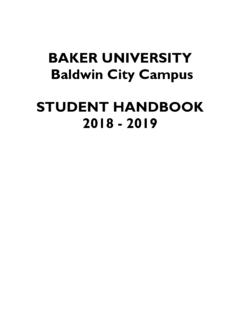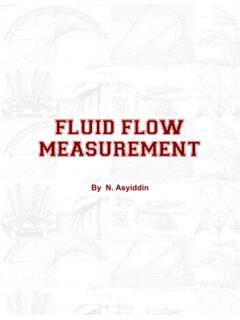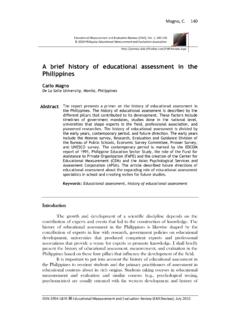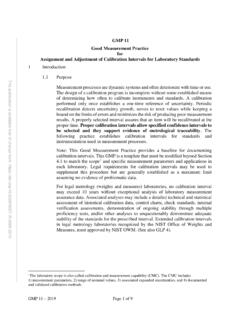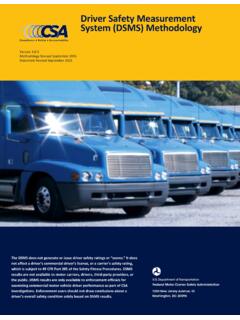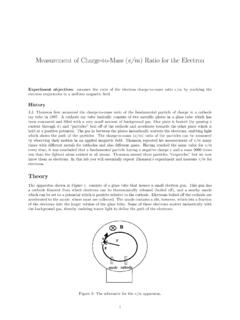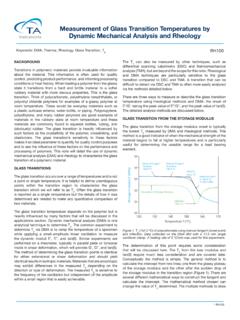Transcription of A MEASUREMENT OF STUDENT SATISFACTION ... - Baker …
1 A MEASUREMENT OF STUDENT SATISFACTION LEVELS AS A MEANS OF PROGRAM EVALUATION: AN EXAMINATION OF Baker university S EDUCATIONAL LEADERSHIP DOCTORAL PROGRAM Douglas A. Sumner , university of Kansas, 1988 , university of Kansas, 1994 Submitted to the Graduate Department and Faculty of the School of Education of Baker university in partial fulfillment of the requirements for the degree Doctor of Education in Educational Leadership March, 2008 Copyright 2008 by Douglas A. Sumner ii CLINICAL RESEARCH STUDY COMMITTEE Major Advisor iii ABSTRACT Considering the social, professional and academic issues currently challenging the field of education, not to mention an aging workforce in the area of school leadership/administration, many graduate level school leadership programs are taking steps to redesign the theoretical context and traditional delivery systems that have long been a trademark of these programs.
2 As the need for qualified, capable school leaders continues to grow, STUDENT attrition rates in doctoral programs in education remain high. A primary reason for this increasing gap between supply and demand is a failure by many institutions to properly consider and assess STUDENT SATISFACTION within their programs. The Mission of Baker university s Ed. D. in Educational Leadership program is to develop leaders who have a strong knowledge base and a sense of beliefs and values supported by educational research and best practices; and who have the passion, commitment, and skills to transfer knowledge, beliefs, and values into policy and practice.
3 The two fold purpose of this study was to determine the level of overall SATISFACTION by students participating in the first two cohorts in Baker university s Doctorate of Education in Educational Leadership program, and the influence of various demographic factors on program SATISFACTION . A convenience sample of two cohorts of students (n=46) enrolled in Baker Ed. D. program (from 2005 and 2006), who agreed to participate in the study, were administered a questionnaire aimed at assessing their SATISFACTION in the areas of Collegiality, Program Schedule, Curriculum Content, Advising and Instruction. The findings of the study showed that participants in the study expressed general SATISFACTION across all of the design components of the Baker Ed.
4 D. program and also identified some areas that may iv require further examination/consideration. The researcher recommended that these findings may be used to guide the university s efforts in continuous program improvement. The results of this study may also serve as an initial indication of program quality. v ACKNOWLEDGEMENTS & DEDICATIONS Appreciation is expressed to the entire faculty and staff of the Baker university Doctorate of Education in Educational Leadership program. Your vision in developing a doctorate level leadership program that not only offers a course of study that is directly related to the current and future challenges facing American public education, but also maintains a genuine interest in the needs of your students, is both admirable and inspiring.
5 I would also like to specifically thank Dr. Harold Frye, my advisor, for his continual support, encouragement and willingness to provide Cohort 1 with a voice in the on-going development of this program. You asked for, and certainly earned, our trust and gratitude. Thank you also to the members of my research committee, Dr. Elizabeth Sanders, Dr. Joe Watson and my friend and colleague, Dr. Christy Ziegler. Please know how much your time, guidance and expertise was appreciated throughout this process. I could not have succeeded without you. I have often said, no one succeeds in education alone and that has certainly been true for me.
6 I have been fortunate throughout my professional career to be mentored by a number of outstanding individuals, Dr. Jerry Bailey, Dr. Jim Davis, Dr. Bill Gilhaus, Dr. Marilyn Layman, Dr. Joe Novak and Mr. Jack Waugh. I have learned a great deal from each of you, and I will keep the knowledge of these special lessons with me always. Thank you all so very much for your friendship and support. Education is a business of the heart and this work, like any I complete, is dedicated to my loving family; especially to my wife Monica, my boys Cade and Blake, my brother Scott and my grandfather Gratton. This work also represents a tribute to the vi lessons learned from my father, Bradley Sumner (a gentle giant).
7 Although you were taken from us much too soon, your loving memory will never be lost from my heart or mind. I love you dearly and am so fortunate to be your son. vii TABLE OF CONTENTS Page LIST OF TABLES .. x LIST OF FIGURES .. xi CHAPTER 1 INTRODUCTION .. 1 Background to the Study .. 6 Program Mission .. 8 Problem 10 Purpose of the 11 Significance of the 11 Overview of Methodology .. 13 Research Questions .. 14 Research 15 16 Delimitations .. 16 Assumptions .. 16 Definition of Key Terms .. 17 Organization of the Clinical Research Study .. 18 CHAPTER 2 LITERATURE REVIEW .. 19 History and Current State of Educational Leadership Preparation Programs.
8 19 Elements of Successful Educational Leadership 29 viii Educational Leadership Program at Baker university .. 32 Effects of Successful Preparation in Educational Leadership .. 34 Program Evaluation .. 37 CHAPTER 3 METHODS .. 41 Research Questions and Hypotheses .. 41 Research Design .. 42 Population and 43 44 Data Collection Procedures .. 47 Data 48 CHAPTER 4 RESULTS .. 50 Reliability of Measure .. 51 Descriptive Statistical Findings .. 52 Findings for the Research Hypotheses .. 63 69 CHAPTER 5 SUMMARY, CONCLUSIONS AND RECOMMENDATIONS .. 70 Introduction .. 70 Summary of Findings for the Research Questions.
9 71 Implications and Limitations of 75 Conclusion and Recommendation .. 76 Recommendations for Further Research .. 77 ix WORKS CITED .. 79 APPENDIX 1: Required Curriculum for DLL .. 86 APPENDIX 2: Baker university Curriculum Requirement for Ed. D .. 88 APPENDIX 3: Clinical Research Requirements .. 90 APPENDIX 4: Survey Instrument .. 93 APPENDIX 5: Open-ended Survey Comments .. 105 APPENDIX 6: Diagrams for Demographic Relationships .. 111 APPENDIX 7: Least Squares Means Graphs .. 117 x LIST OF TABLES Page Table 1 Number of students and participants in each 44 Table 2 Reliability of 51 Table 3 Demographic profile of participants (n=46).
10 53 Table 4 Frequency Percentage responses to the study 55 Table 5 Descriptive Statistics for the sample Program Design Component Means (n=46).. 61 Table 6 Pearson s Correlations between the program design components of the 63 Table 7 Test Results for differences in levels of SATISFACTION between the 64 Table 8 Test Results for differences in levels of SATISFACTION between those with and without administrative 65 Table 9 Test Result for differences in levels of SATISFACTION between the two 66 Table 10 Test Result for differences in levels of SATISFACTION between the Age 67 Table 11 T-Test Results for differences between the Program design component Means68 xi LIST OF FIGURES Page Figure 1 Two-Wheeled Model for the Conceptual Framework
